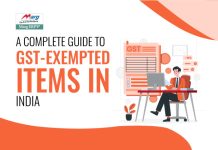Goods and Services Tax (GST) is a consumption-based tax that has been implemented in India to replace multiple indirect taxes such as excise duty, service tax, value-added tax, and others. The GST system has been designed to streamline the taxation process, reduce the burden of tax compliance, and create a uniform tax structure across the country. One of the critical elements of the GST system is the GST threshold limit, which is the minimum annual turnover limit above which a person is required to register for GST.
What is the GST threshold limit?
The GST threshold limit is the minimum annual turnover limit above which a person is required to register for GST. The GST threshold limit was introduced to reduce the compliance burden on small businesses and to promote ease of doing business. In India, the GST threshold limit varies for different categories of businesses.
For businesses that deal in goods, the GST threshold limit is as follows:
- For businesses operating in the North Eastern and hill states of India, the GST threshold limit is Rs. 10 lakhs.
- For businesses operating in the rest of India, the GST threshold limit is Rs. 40 lakhs.
For businesses that provide services, the GST threshold limit is as follows:
- For businesses operating in the North Eastern and hill states of India, the GST threshold limit is Rs. 10 lakhs.
- For businesses operating in the rest of India, the GST threshold limit is Rs. 20 lakhs.
It is important to note that the GST threshold limit applies only to businesses that operate within the state. If a business operates in multiple states, it is required to register for GST regardless of its turnover.
Benefits of the GST threshold limit
The GST threshold limit has several benefits for small businesses. Some of these benefits are as follows:
- Reduced compliance burden: Small businesses with turnover below the GST threshold limit are not required to register for GST. This reduces the compliance burden on small businesses and saves them the time and effort required to comply with the GST regulations.
- Cost savings: Businesses with turnover below the GST threshold limit do not have to pay GST on their sales. This results in cost savings for small businesses, which can be used to grow the business.
- Increased competitiveness: Small businesses with turnover below the GST threshold limit can compete with larger businesses, as they do not have to charge GST on their sales. This helps small businesses to attract customers and expand their customer base.
Read more useful content:
Final Conclusion
The GST threshold limit is an important element of the GST system in India. It is designed to promote ease of doing business and reduce the compliance burden on small businesses. The GST threshold limit varies for different categories of businesses, and businesses with turnover below the threshold limit are not required to register for GST. This provides several benefits to small businesses, including reduced compliance burden, cost savings, and increased competitiveness. Overall, the GST threshold limit is a positive step towards creating a more business-friendly environment in India.
Moreover, the GST threshold limit helps to encourage small businesses to focus on growth and expansion. Small businesses that do not have to register for GST can use the resources that they would have otherwise spent on tax compliance to invest in their businesses, develop new products or services, and expand their customer base. This can help small businesses to increase their turnover and eventually surpass the GST threshold limit, which would require them to register for GST.
Here are some frequently asked questions (FAQs) about the GST threshold limit:
Q: What is the GST threshold limit?
A: The GST threshold limit is the minimum annual turnover limit above which a person is required to register for GST.
Q: What is the GST threshold limit for businesses that deal in goods?
A: For businesses operating in the North Eastern and hill states of India, the GST threshold limit is Rs. 10 lakhs. For businesses operating in the rest of India, the GST threshold limit is Rs. 40 lakhs.
Q: What is the GST threshold limit for businesses that provide services?
A: For businesses operating in the North Eastern and hill states of India, the GST threshold limit is Rs. 10 lakhs. For businesses operating in the rest of India, the GST threshold limit is Rs. 20 lakhs.
Q: Are businesses with turnover below the GST threshold limit required to register for GST?
A: No, businesses with turnover below the GST threshold limit are not required to register for GST. However, they may choose to register for GST voluntarily.
Q: Are businesses with turnover below the GST threshold limit required to pay GST?
A: No, businesses with turnover below the GST threshold limit are not required to pay GST on their sales.
Q: Are businesses with turnover below the GST threshold limit required to file GST returns?
A: No, businesses with turnover below the GST threshold limit are not required to file GST returns. However, if they choose to register for GST voluntarily, they will be required to file GST returns.
Q: What are the benefits of the GST threshold limit?
A: The GST threshold limit reduces the compliance burden on small businesses, saves them from the time and effort required to comply with the GST regulations, and creates a more business-friendly environment in India. It also helps to simplify the tax compliance process, encourages small businesses to focus on growth and expansion, and reduces the burden on the GST network.
Q: What are the drawbacks of the GST threshold limit?
A: The GST threshold limit may create a two-tier system where larger businesses have to comply with GST regulations, while smaller businesses do not. This may result in unfair competition and market distortions. However, the government has implemented measures to address these concerns, such as the composition scheme for small businesses.
Q: What is the composition scheme for small businesses?
A: The composition scheme is a simplified GST scheme for small businesses with a turnover below Rs. 1.5 crores. Under this scheme, small businesses can pay a lower rate of GST and comply with fewer regulations.






